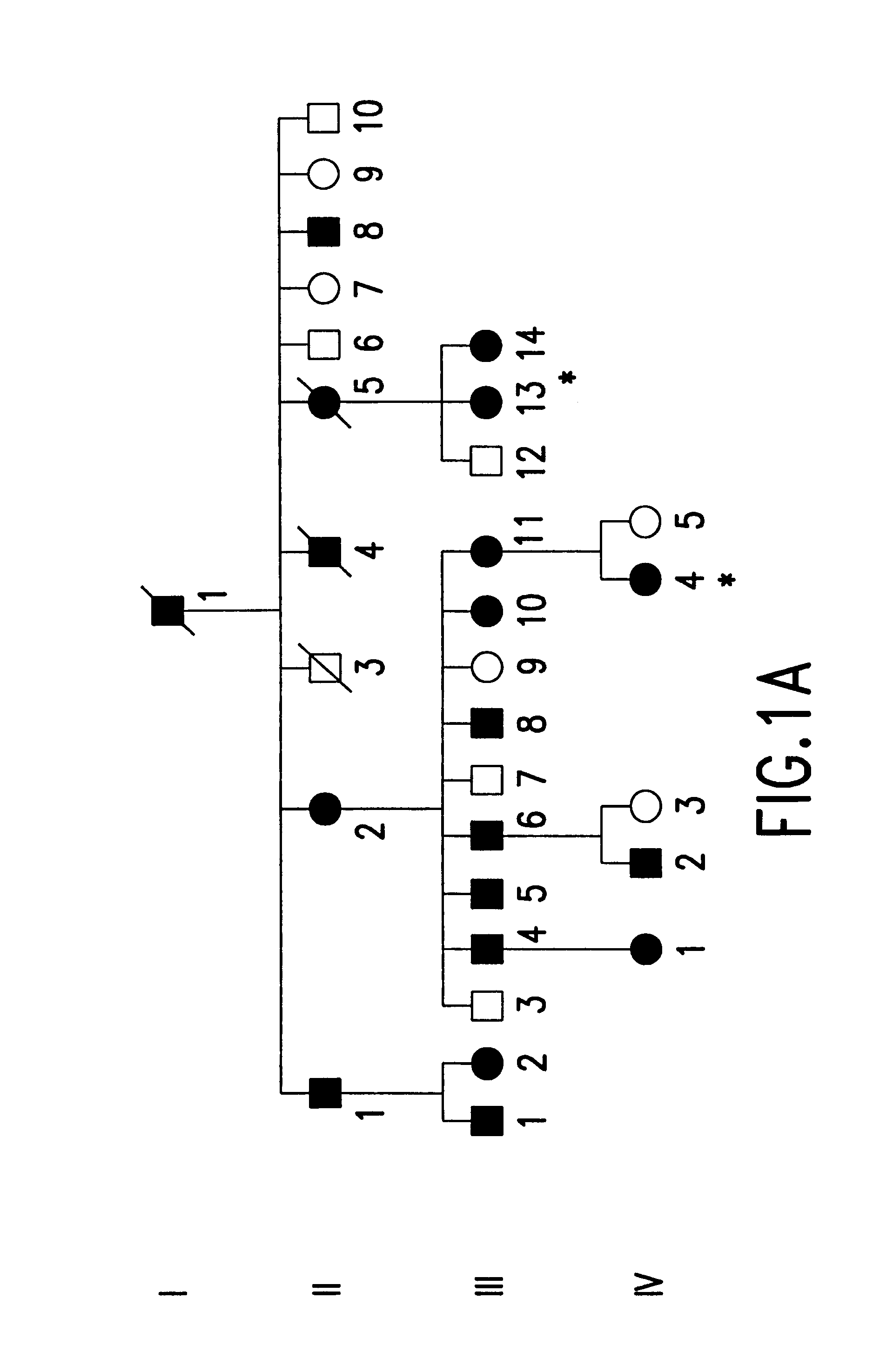Macular degeneration diagnostics and therapeutics
a technology of macular degeneration and diagnostics, applied in the field of macular degeneration, can solve the problems of no treatment that is capable of significantly slowing the degenerative progression, and a significant fraction of typical late-onset macular degeneration, so as to reduce side effects, minimize potential damage to uninfected cells, and increase therapeutic indices
- Summary
- Abstract
- Description
- Claims
- Application Information
AI Technical Summary
Benefits of technology
Problems solved by technology
Method used
Image
Examples
example 1
Genetic Linkage of a Macular Degeneration Causing Gene to the Short Arm of Human Chromosome 2
A total of 86 family members at 50% risk for autosomal dominant radial drusen were studied (FIG. 1). These individuals belonged to four families that were known to be related. Genealogical investigation revealed that family A has lived in the United States since at least the late 1700's. The two branches of this family (A1and A2) were found to be connected by a sibship that lived in West Virginia in the 1790's. Families B-D all originated from the Leventine valley of southern Switzerland. Members of family B have been the subjects of previous reports by Vogt,.sup.23 Klainguti,.sup.24 Forni and Babel,.sup.26 and Scarpatetti, Forni, and Niemeyer..sup.31
Informed consent was obtained from study participants. Seventy-one patients had complete eye examinations (visual acuity, slit lamp examination, indirect ophthalmoscopy and retinal biomicroscopy). The medical records and fundus photographs of 15...
example 2
Identification of WI-8771 (S1-5) (FBNL) as the Macular Degeneration Causing Gene
The Assay
A limitation to the assay of the above genes for mutations has been the paucity of available in formation about the genomic structure and genomic sequence of these genes. Thus, many assays have been limited to selected regions of the coding sequence 20 or more base pairs away from intron-exon boundaries. Because of these limitations, negative screening results have been difficult to interpret (because true disease-causing mutations could be located in the unscreened regions of the genes).
Work was thus directed to identifying the genomic structure and genomic sequence of the most promising candidate genes, so that more complete assays could be developed. It was found that aportion of the s1-5(FBNL) gene (Genebank Accession U03877--SEQ. ID. No. 1). The relevant portion is exon 10 inclusive of previously unpublished intronic s equenc e (SEQ. ID. No. 2). The availability of this new intronic sequenc...
example 3
Identification of an Additional Mutation in WI-8771 (S1-5) (FBNL)
As described above, all 37 families (162 affected patients) studied had an exon 10 shift on SSCP that looked identical. All of the families were then sequenced to make sure that it was all the same mutation. All of the families sequenced had the Arg345Trp mutation found in the original patients. However, the sequence of one Swiss patient came back and had a different amino acid changing mutation in exon 10: namely, Arg362Gln. This mutation, therefore, could be responsible for Doyne's dystrophy, while the Arg345Trp mutation is responsible for the malatia leventinese form of age related macular degeneration.
Equivalents
Those skilled in the art will recognize, or be able to ascertain using no more than routine experimentation, many equivalents of the specific embodiments of the invention described herein. Such equivalents are intended to be encompassed by the following claims.
PUM
| Property | Measurement | Unit |
|---|---|---|
| diameter | aaaaa | aaaaa |
| volume | aaaaa | aaaaa |
| nucleic acid | aaaaa | aaaaa |
Abstract
Description
Claims
Application Information
 Login to View More
Login to View More - R&D
- Intellectual Property
- Life Sciences
- Materials
- Tech Scout
- Unparalleled Data Quality
- Higher Quality Content
- 60% Fewer Hallucinations
Browse by: Latest US Patents, China's latest patents, Technical Efficacy Thesaurus, Application Domain, Technology Topic, Popular Technical Reports.
© 2025 PatSnap. All rights reserved.Legal|Privacy policy|Modern Slavery Act Transparency Statement|Sitemap|About US| Contact US: help@patsnap.com



